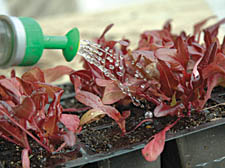|
|
 |
| |

Watering plants |
Simple steps to stop your plants being hung out to dry
Schoolboy watering errors are easy to avoid, says Tom Moggach
IT'S been a topsy-turvy fortnight, with scorching sun then sloshing rain, so it’s the right time to tackle the problem of thirsty plants.
Watering sounds straightforward. And it is – to a point. But it’s also weirdly easy to get it wrong, leaving a trail of parched or soggy plants. June is a month to be extra careful, now that our growing season is in full swing.
In general, my first rule of thumb is to slow right down – not always easy in the hurly-burly of London. Gardening, they say, is about tuning in to what plants need. And watering in a rush does more harm than good. Plants love a long soak, not a quick sprinkle.
Spraying water over their leaves is also pointless. Plants draw up moisture with their roots, so water to the base of the plant. You want their roots to sink down in search of water, strengthening and anchoring the plant in the process.
Timing is the tricky one. Over-watering is just as bad as neglect. At home, I do a quick circuit around my plants each morning. Touch or dig into the soil with your fingers to check if it’s drying out. Then water, if needed, at the beginning or end of the day to keep evaporation to a minimum.
Out in the garden, a hose on full blast can damage delicate plants, dislodge seedlings and disturb soil structure. A trigger helps to control the flow and create a spray. In terms of kit, soaker hoses are a wise investment. You drape them around the plot and they slowly drip irrigate your plants.
If you’re flash, you can even buy mini computers which control the whole watering process.
If you talk to the old-school gardeners, they seldom water their plot.
Most established plants don’t need it. Adding organic matter makes the soil more moisture retentive. A two inch layer of mulch on top, such as home compost, does the same job. Use the same strategy with pots – gravel also works.
Indoors, house plants obviously need much more attention. Get a feel for how heavy your pots are when well watered. Any outdoor container will also dry out quickly. Hanging baskets are the worst, needing daily watering in hot weather.
One tip, if you have a collection of pots, is to group them all together to reduce the effects of the drying wind. So keep a close eye on those exposed pots on your window ledge.
For seedlings, be extra vigilant. I’m a big fan of an ingenious invention – the bottle-top waterer. It costs just 50p and screws on the top of old mineral water or tonic bottles to create a gentle spray that’s ideal for delicate plants. Buy them from Garden Innovations – a company that specialises in watering devices (www.garden-innovations.co.uk).
When sowing seeds, it’s best to use sterile tap water. But rain water is ideal for established plants. Camden Council’s website has information about sustainable gardening and will point you in the direction of water butts for around £50, which you tap into your drainpipes. Right now, food plants such as courgettes, tomatoes, peas, beans or soft fruits are often thirsty – imagine the water they need to swell up the edible bits. Water leafy salads whenever the soil feels dry, preferably in the morning to deter pesky slugs at night. But otherwise, to be honest, most veg seldom needs watering attention.
•
|

|
 |
Your comments:
|
|
 |
|

